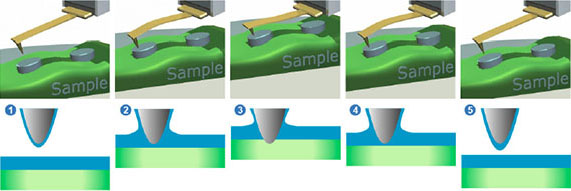HD mode
HybriD mode working principle
In HybriD mode the tip-sample distance is modulated according to the quasi-harmonic law. Thus tip enters a force interaction with the sample thousands times per second.

Fig.1.
Main stages of the measurement cycle in the HD mode for the idealized displacements of the probe are shown in Fig. 2. At large distances between the probe and the sample, deflection of the cantilever remains constant, being at the base level (point 1 of the deflection profile); with further approach, the cantilever bends downward under effects of capillary adhesive forces (point 2). On further approach, when the repulsive tip-sample forces dominate, the bending reverses upwards until it reaches the set-point level (point 3) chosen for lateral scanning feedback. This is the turnaround Z-position of the cycle. As the sample and the tip depart, the probe might experience strong adhesive interactions reflected by a well (point 4) in the deflection, before the probe fully detaches from the sample and the cantilever restores its baselinedeflection (point 5).

Fig.2. Probe deflection curve. 1, 5 – baseline; 2 – minimum attraction/adhesion force during approach; 3 – maximum deflection; 4 – minimum attraction/adhesion force during retraction
Force-distance curve analysis enables maps of topographical, nanomechanical, electrical, thermal and piezoelectric properties of the sample to be extracted with high spatial resolution and minimized lateral forces.
High-performance electronic components and unique algorithms implemented in the state-of-the-art HybriD 2.0 Control Electronics provide superb level of real-time signal processing and analysis.
Combining mode with cutting-edge optical microscopy and spectroscopy techniques opens-up novel opportunities of cantilever-based tip-enhanced Raman scattering (TERS) and scattering scanning near-field optical microscopy (s-SNOM).
Rebirth of Force Spectroscopy: Advanced Nanomechanical, Electrical, Optical, Thermal and Piezoresponse Studies
- Fast Quantitative Nanomechanical Measurements and Force Volume
- Simultaneous Electrostatic and Non-destructive Conductivity, Piezoresponse and Thermal Studies
- Advanced Cantilever-Type Tip-Enhanced Raman Scattering and Scanning Near-Field Optical Microscopy
HybriD mode (HD mode) – scanning technique based on fast force-distance curves measurements with real-time processing of tip response.
Measured properties:
- Topography in Attraction and Repulsive Regimes
- Young’s Modulus and Force Volume
- Adhesion and Work of Adhesion
- Conductivity
- In-Plane and Out-of-Plane Piezoresponse
- Temperature and Thermal Conductivity
- Thermoelectric
- Electrostatic: Kelvin Probe Force, Electrostatic Force and Scanning Capacitance Force Microscopy
- Near-Field Component of Optical Response
- Tip-Enhanced Raman Scattering
Downloads:
Application Note 087 "Expanding Atomic Force Microscopy with HybriD Mode Imaging"
Application Note 098 "HybriD Piezoresponse Force Microscopy”






